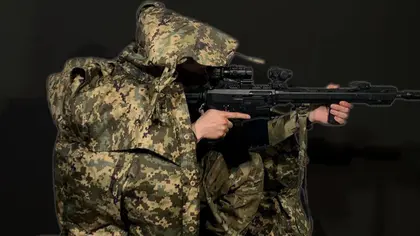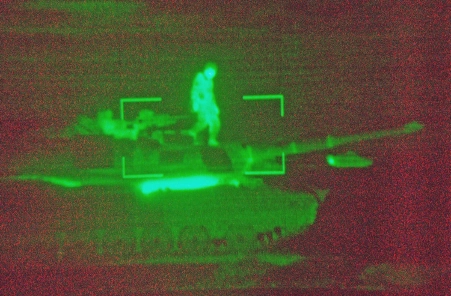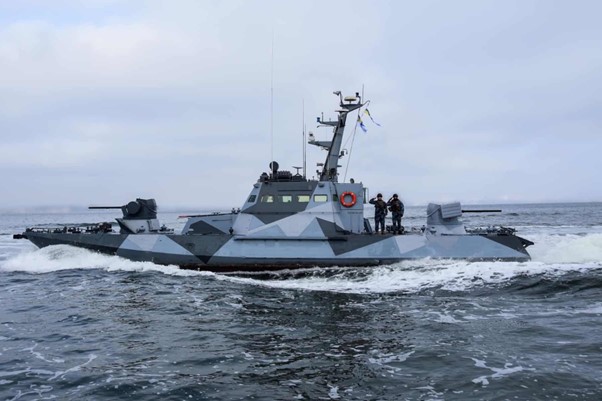The ability to be invisible to the enemy when moving around the battlefield has been the holy grail for the military since the introduction of the first camouflage uniforms in the 19th century. Ukraine’s new field jacket, which Fedorov revealed on his “X” account on Wednesday has perhaps brought that wish one step closer.
Have u ever read about invisibility cloaks in fairy tales? Well, Ukrainians made it. The cloak blocks heat radiation & makes defenders invisible to Russian thermal cameras. It will help our soldiers work effectively during the night. Miltech magic supported by @Brave1ua cluster. pic.twitter.com/7OIE4Ciq2c
— Mykhailo Fedorov (@FedorovMykhailo) October 4, 2023
What is thermal imaging?
Typical TI image of a tank. Photo: Screenshot from YouTube
Thermal imaging (TI) is the passive detection of the infrared (IR) radiation (heat) emitted by a vehicle or the human body and to identify it as a military threat. It doesn’t matter how well something is camouflaged – if it’s warmer or cooler than its background, it will show up.
On the battlefield, the ability of TI to detect a target depends on the temperature difference between the object and its surroundings. Simple (cheap) TI imagers will tell you that there is something or someone there. Sophisticated and sensitive (expensive) equipment may allow you to identify exactly what is there and enable you to engage the target.

Up-Armored Ukrainian Leopard Tank Survives Multiple Russian FPV Drone Strikes
Previously military TI was highly expensive “classified” technology, limited to those militaries with pockets deep enough to afford it. But like most technologies, TI has become cheaper and more accessible over time, a perfectly adequate TI imager can be bought in any reputable electronics store for a couple of hundred dollars.
TI in Ukraine
In the West, much of the research and development (R&D) into countering the TI threat has focused on protecting vehicles, headquarters complexes, and the like. This has led to a number of novel, high-end technology solutions: such as BAE Systems’ adaptive vehicle cloaking technology, a “honeycomb” system that allows individual cells on the outside of the vehicle to be heated or cooled to match its background; Hyperstealth Biotechnology’s light-bending Quantum Stealth material technology, that bends light waves around the target to make it invisible; and the Japanese invisibility cloak developed by Dr. Susumu Tachi, which uses nanoantennae technology to redirect light waves around an object.
The initial stages of the war against Russia’s full-scale invasion were conducted as a classic armored vehicle-borne assault. Now, during Ukraine’s current counteroffensive, it has increasingly become an operation carried out by dismounted infantry trying to break through the minefields and other obstacles Moscow’s troops rely on for protection.
This and the fact that TI capability is not just limited to the tank and gun mounted sights, with which most modern military vehicles are now equipped, but are carried on many drones and are slung around the neck of every other soldier. TI imagers are the number one request made on Ukrainian Telegram channels when appeals for equipment donations are being made.
While the US and others have made efforts to protect special forces troops such as snipers from TI detection there has surprisingly been little R&D into protecting the individual ordinary soldier – until now.
The Russian invisibility blanket.
Reports began to appear earlier this year that Russian troops were attempting to conceal their heat signatures by covering themselves with ponchos made from “mylar” metalized polyester or “space blankets.”
A Ukrainian officer using the name Tatarigami identified this in a post on “X” on April 24, that found a number of Russian troops that were captured or killed in fighting near Avdiivka near the city of Donetsk in Eastern Ukraine were wearing such blankets.
It’s not a new trick, the Taliban in Afghanistan was known to use “space blankets” to try and reduce the odds of detection by NATO forces and so have some Ukrainian volunteers.
🧵Thread
— Tatarigami_UA (@Tatarigami_UA) April 24, 2023
1/ Another noteworthy development in the ongoing invasion is the reported use of anti-thermal blankets/coats by russian soldiers in close proximity to Donetsk. pic.twitter.com/ho2NuX3l7Z
Ukraine’s “Invisibility Raincoat.”
For obvious reasons, the unveiling of Ukraine’s new clothing does not reveal much in the way it works. Fedorov has declared that is designed to be “compact and lightweight – up to 2.5 kg. It has high protection against rain and wet snow. Also, the raincoat does not burn and protects against high temperatures. The video shows a finished sample that has successfully been tested in the field.”
The video shows three static figures filmed using a TI camera, one presumably wearing the raincoat and two not. It doesn’t indicate the conditions of the three and whether they have been motionless for some time. It would be interesting to see how well it would work if the user exerted themself which would raise their body temperature.
It does look, however, that while the results aren’t perfect – the dappled outline of the coat wearer was visible in Fedorov’s video – but will stand out far less than a regularly clothed soldier and be much harder to pick out during an area scan, particularly against the lower-quality or shorter-range commercial thermal imagers that have proliferated on Ukraine’s battlefield.
You can also highlight the text and press Ctrl + Enter









![[WATCH] Russian Dirt Bikes – No Match for Ukrainian Kamikaze Drones](https://static.kyivpost.com/storage/2025/01/27/9c6ad078d922242f67865201e2654ca3.png?w=420&q=75&f=webp)

